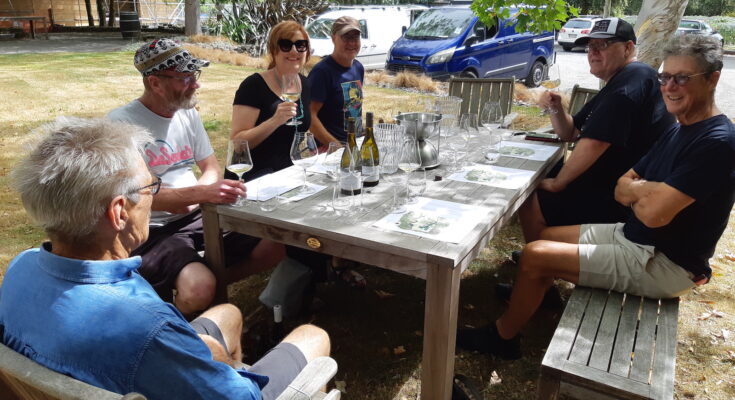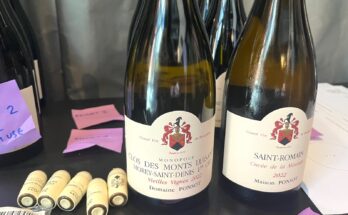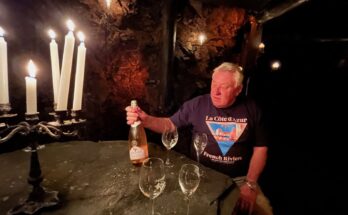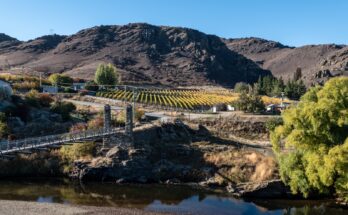I’ve been invited down to “Pinot Day 2022” – an annual weekend of celebration, with Pinot Noir, good food, and friends, created by good friend Curt Thomas. It’s my first time being able to come along, and a bit of an auspicious occasion as it is the first time it has been held in Martinborough – the spiritual home of New Zealand Pinot Noir. A group of us (Curt, Gabor, John, Alistair, Evelyn and myself) are visiting Ata Rangi today to spend a couple of hours with founder Clive Paton, who is a long-time friend of Curt, and has agreed to host us for the morning.
Clive Paton: I think we’ll have a look at what’s happening now, and then maybe pull out a few older things to look at? A lot has happened in the last forty years, and I know that three of you here today have known me for that journey. Extraordinary – we were all young then!
Curt Thomas: One thing I appreciate about you as a person is your conservation, and the work with the bush block. And it’s not something that a lot of people know about? I’ve been there a couple of times, in the old pig hunters hut. That was still one of the most special things I’ve ever done. We sat there and you put the billy on, and made some damper. I just thought ‘what a magical, magical place’.
CP: We’ve kept that original pig hunters hut as a bit of history for the district, and we’ve built around it. Exactly what I do with it in the future, I’m not sure. Not sure I trust people to have the same empathy with it. There’s 50 acres of beautiful vineyard land there, which evolved and was uplifted, at the same time as these terraces. Just the boulders are bigger.
There’s a Weather Station nearby which I use when I need to. Even before I went there, they had records from forty years back. So it was pretty interesting then and would be even more interesting now. I’ve got a sense of what has happened and the biggest change of course has been the Winters. They’ve gone from three months to two months, in the space of fifteen years. So what happens then? Bud burst is much earlier, so you’re in a higher frost zone for longer. And it means that you’re ripening in the middle of Summer.
The thing about Martinborough is that because we’ve got sea not far away, our climate is mediated by that – and we don’t get too hot and we don’t get too cold. Most of our rain comes from the South – although what we’re getting in the next few days may not! I’ve hardly seen botrytis problems here in forty years.
CT: So your Late Harvest wine is not a botrytis wine?
CP: Well, it’s got a heavy dew situation. It has some big gum trees at the bottom, and it doesn’t get that westerly breeze.
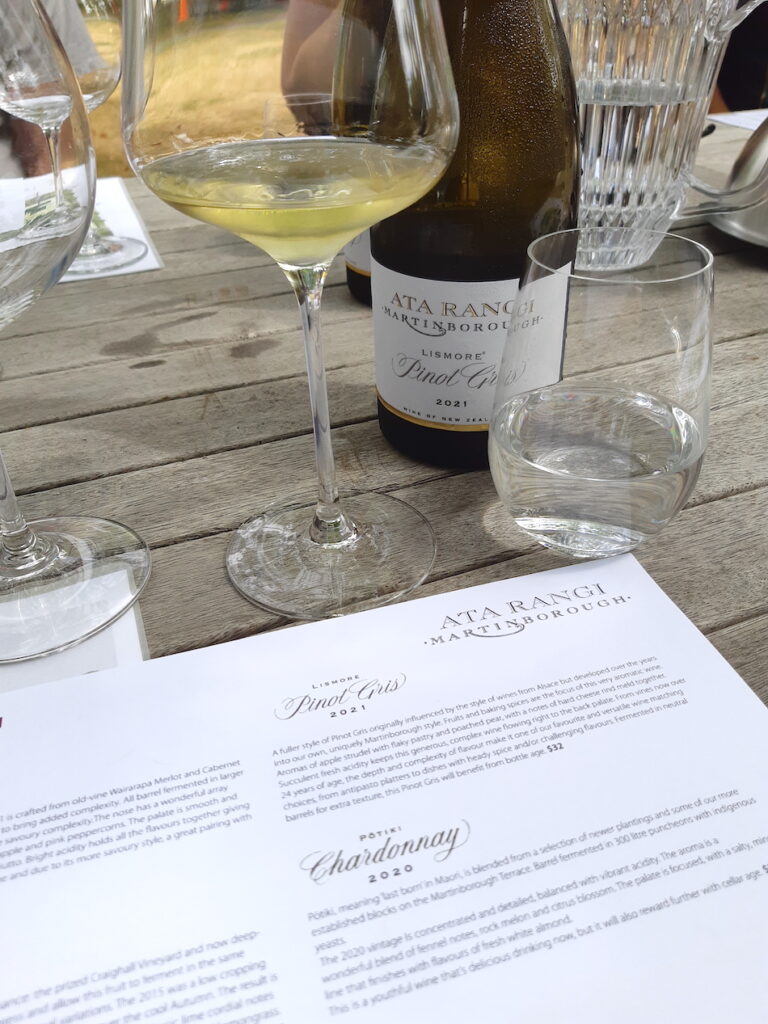
If you had a line up of ten, you’d work out the years with the heavy dew. All the vineyards are different, even on a flat piece of land – but there’s always gravel in the mix. It is great when you get a true botrytis wine. I had a ’79 Y’quem six months ago, and I’ve had various over the years, but this was just unbelievable.
WF: You start to get religious when you have something like that. There is a God, and he wants me to have this.
CP: As a winemaker, you need it too. Because you want to produce wines of that quality yourself. But you also know it is the combination of many things. The season, the variety, the whole shebang. Some people seem very blasé about the changes in our climate. I’ve been thinking fifty years ahead ever since I went to that Al Gore movie – an Unfortunate Truth. I thought, well if he’s correct – we’re in trouble. Because here we’re at the warm end of the Pinot spectrum, but it works and we survive because of those southerlies keeping that cool air coming through and the diurnal shifts.
WF: Has the rainfall changed much over time, or been consistent?
CP: Consistently dry! To give you an example, we have had the driest November in record. But then in early December we have had 100mils and 30mils about a week later. Because I’m a tree planter I worry more than most people. I usually plant two or three thousand trees a year, and that first year is always critical. The last few years I’ve been getting the coffee sacks from L’Affaire – a big ute load every three weeks. Normally you’d spray a patch out before you plant, but now I can plant straight into the grass, put the sacks down and Bob’s your Uncle. Keeps the weeds out, and you don’t get the evaporation and that’s been hugely helpful.
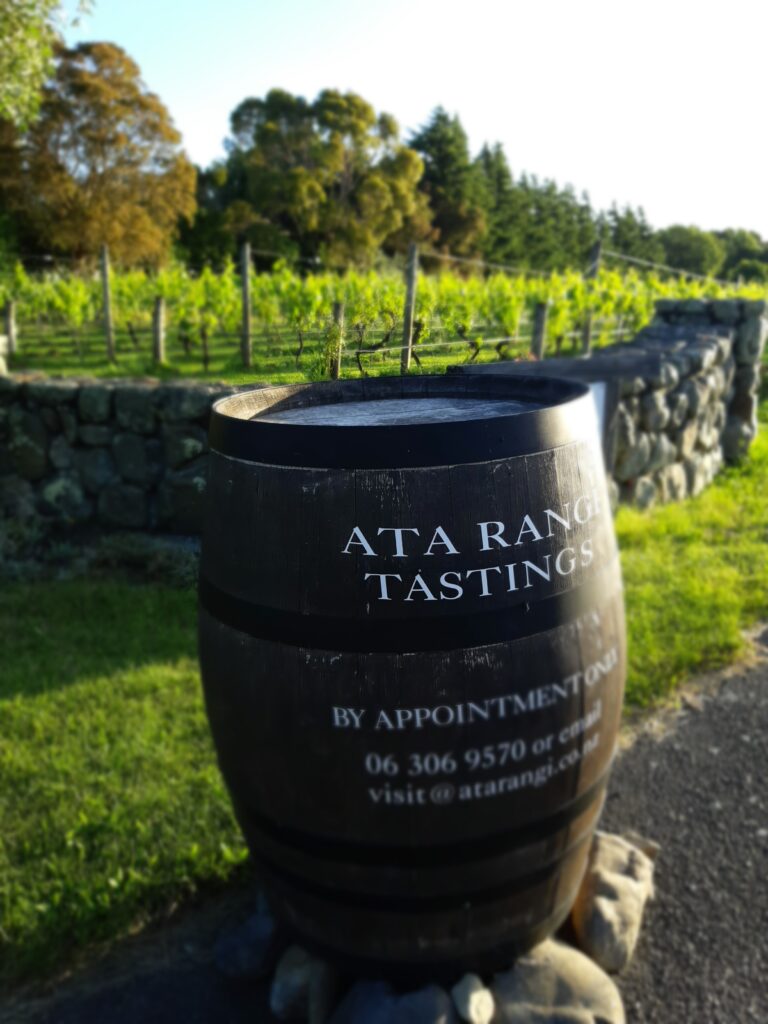
With the Bush Block, I got really lucky – a local Real Estate Agent called me up and said can you come and comment on a piece of land further down the valley which was part of a 1000 acre farm. And there was 50 acres of just beautiful grape land there, with slightly higher – about 10% higher, rainfall. While we were there he took me up the back and said ‘you might be interested in this piece of bush up the back’. And I was. It took me a year to convince my sister and wife to purchase it.
We move onto wines…
CP: We’ll start with our Pinot Gris – this comes from a little separate terrace, quite low and slightly frost-prone. We’re sitting a on a strip of clay about fifty metres wide, that goes about two and a half kilometres right through the middle of the gravel terrace. It’s a very, very fine clay, so that during the winter it just goes into porridge, but in the summertime it is like concrete. So, comments from you guys on Pinot Gris in New Zealand?
WF: It can have lovely aromatics. On this one there’s a lovely pear characteristic, maybe a touch of guava. It has consistently got drier over the years – it used to be quite a lush thing.
CP: Well I grew up having available, and loving, a lot of Alsatian Pinot Gris. Those big, alcoholic, sweet bombs, and that’s what we started off doing, and we had 15 grams of sugar in those early ones. And gradually we’re down to about three, and we’re sort of happy there. We make a reasonable amount and we manage to sell that every year. Now of course we’ve got vine age which makes a difference. I think we’re slowly getting to a point where we have a New Zealand style. Parts of New Zealand that are on gravel terraces where your crop is restricted makes a big difference. If you’ve got older vines with medium to small crops, you’re going to get more texture and better acidity. To me, in any wine, those two things are important.
WF: When I came to Ata Rangi a year ago, I got the impression that is was a company led by strong women – and you just did what you were told! Is that controversial?
CP: No, that is correct. I’m still involved every day, but I think they’d like me to go to the Bush Block full time (laughs). I consider myself very lucky actually, to still be part of something like a good winery. A lot of the other things I do have a connection to here. I doubt we’d be organic if it wasn’t for me. That side of things wouldn’t exist, and it is very much part of who we are – otherwise we’d just be another winery. You guys are looking at those smaller wineries all the time, so you know. You’ve got Kai and Marion who are doing great things and have a different persona about the whole thing. We’re really lucky in Martinborough.
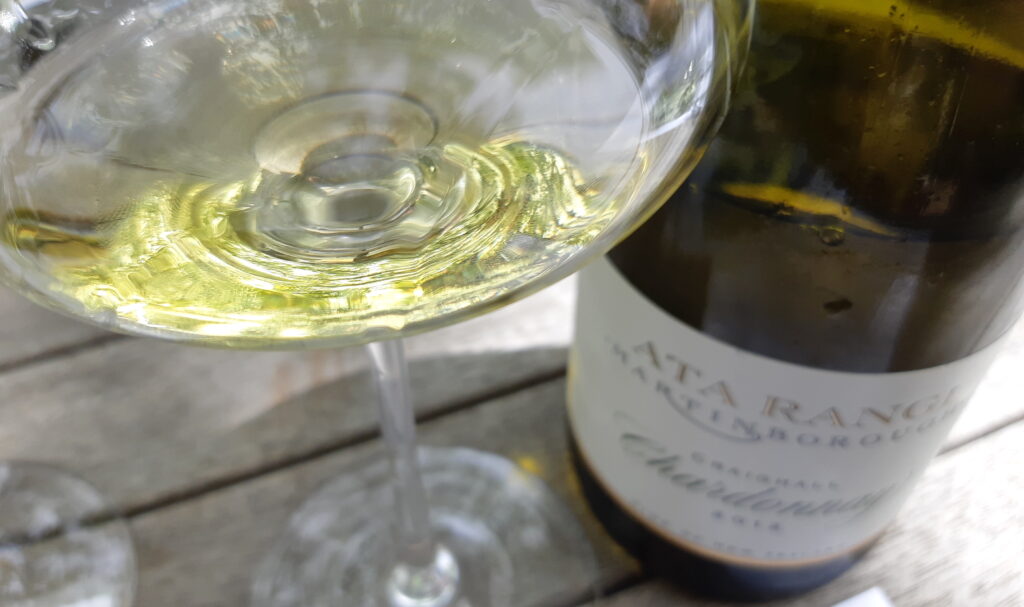
WF: I got the feeling though that – a bit like Felton Road – that you deliberately had the intention to keep the business at a size where it is manageable with a small team, and you are able to keep producing a product that you’re all really proud of?
CP: Absolutely. At our next shareholder meeting – and there’s only three shareholders – we’ll be talking about how big we should be, and can be. We’re fairly stretched at the moment in terms of labour. That will change, but we are on the world market. There’s a good chance that three of the four children could be involved in the business. Ness who has been involved here for the last five years, and looks after the Wine Shop and all the things that make that a very busy place. She married a winemaker – John Kavanagh – who is at Te Kairanga now. She’s interested in being part of the future. And MacKenzie of course, who has an extraordinary wine knowledge – and especially in Champagne. Some of the Charles Heideseck I’ve drunk since she’s been there has been just sensational.
WF: I notice that you’ve now got the Masters Chardonnay in the line-up. Does that soften the blow of losing the Craighall Chardonnay for the years whilst that’s being replanted and coming back? What was the last vintage of Craighall?
CP: Yes, that’s Helen’s vineyard which is about twenty years old. You really need to try that – it’s a real standout. 2019 was the last vintage of Craighall. What happened was that in the first two years there was no rootstock available in New Zealand that wasn’t virussed, so nobody went near rootstock and all of us planted on our own roots just to keep going. And then from ’82 onwards we started planting on rootstock. It wasn’t phyloxera – that’s only really been spread by tractors and picking machines. We haven’t had any at all. It doesn’t like the dry gravels. It prefers a bit more moisture I think.
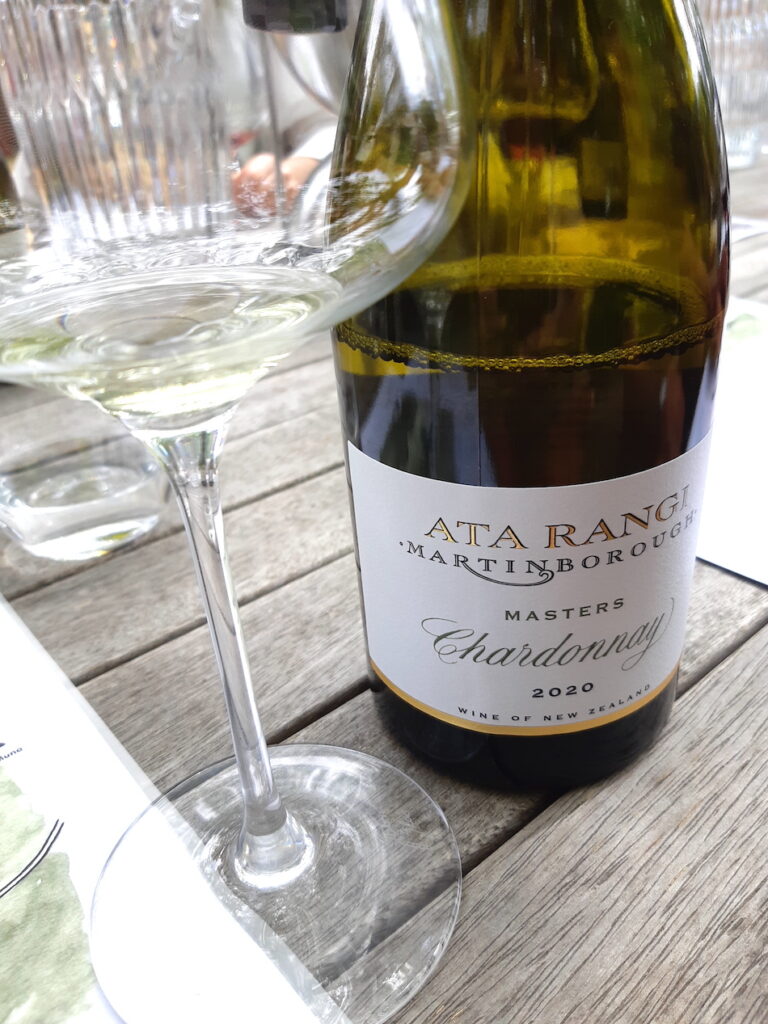
It’s amazing when you look back, the variations through the years. This 2012 Craighall was during that year when we had our coldest February and March ever and we didn’t pick until the first week of April. It rained and drizzled and was cold, but we had three clear weeks right at the end. It created this wine with fantastic acidity.
We’re joined by Helen Masters, the winemaker at Ata Rangi, as we are passing round some French Burgundy that we brought to try alongside the Ata Rangi wines…
HM: We had a Corton ’19 and it was too ripe. It depends upon the house – if they’ve used a lot of oak and it is quite ripe, then they’re generally unapproachable now. Maybe in another five years. Sometimes there’s a “we pick on this date” mentality. “That’s what we’ve done historically” and you just have to really stop and dump that and look at the fruit, look at the acid profile. I think they’ll learn in Burgundy that as they’re getting higher alcohols, they’ll have to back off oak. You’ll notice in a wine that is 14% compared to 13%, that the oak is so much more extracted by the one percent more alcohol.
We’ve learnt that because certainly in the early days we had higher alcohol, and it was about understanding that – and back off heavy char as well, because that will pull it all out. So they’ve prescribed 70% new oak, but in a warm year you may need to back off to 50%. They still use a lot of oak!
WF: Really happy to try the Chardonnay with your name on it, Helen. That wasn’t available the last time I was here a year ago.
HM: We’ve had this vineyard for seven years, but it was started by two ladies back in 2001, and we’ve taken the fruit for Ata Rangi since ’07. We always said to them that if they ever wanted to sell it, that me and my husband would buy it. And in 2015 we did. The fruit comes here to Ata Rangi and it always had a lovely and quite distinctive character, and different to Craighall. There’s a bit more clay where I am, and it is a bit cooler. Ripening is maybe a week to two weeks behind in town. The same winemaking as the Craighall would have gone through, but fully through malo.
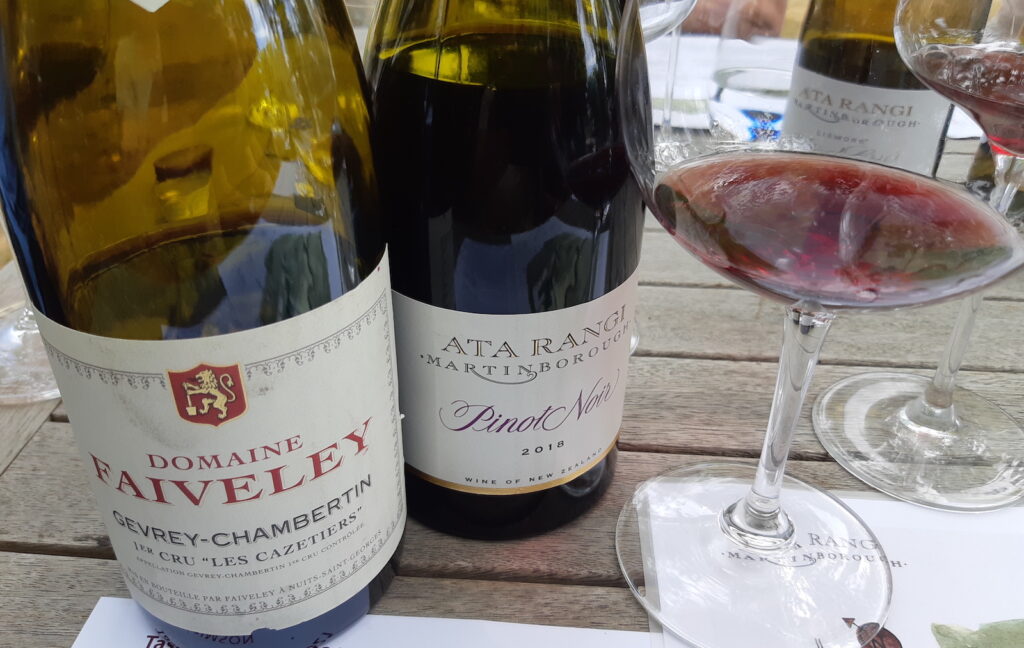
Texturally I think the clay gives more spread, and in the Pinots you’ll see a little more difference. For the 2020s we’ll have the McCrone and the Masters which both have clay components, and will end up being about 50% Abel for both. And we’re also going to bring out Kotinga which is a twenty year-old vineyard just down the road and it is very gravelly. We’ll have three single vineyard wines and then Ata Rangi. They’ll make a nice four.
With the older vines that go down three or four metres where the soil is cooler, the sugars accumulate slower and you’re getting less acid degradation and you’re also getting better seed and skin ripeness. With younger vines, it is trying to get them before the sugar gallops away and getting enough tannin ripeness. The wines there can often seem bigger and gruntier, whereas older vines will be more elegant.
We try the 2018, 2011 and 2013 vintage Ata Rangi Pinot Noirs
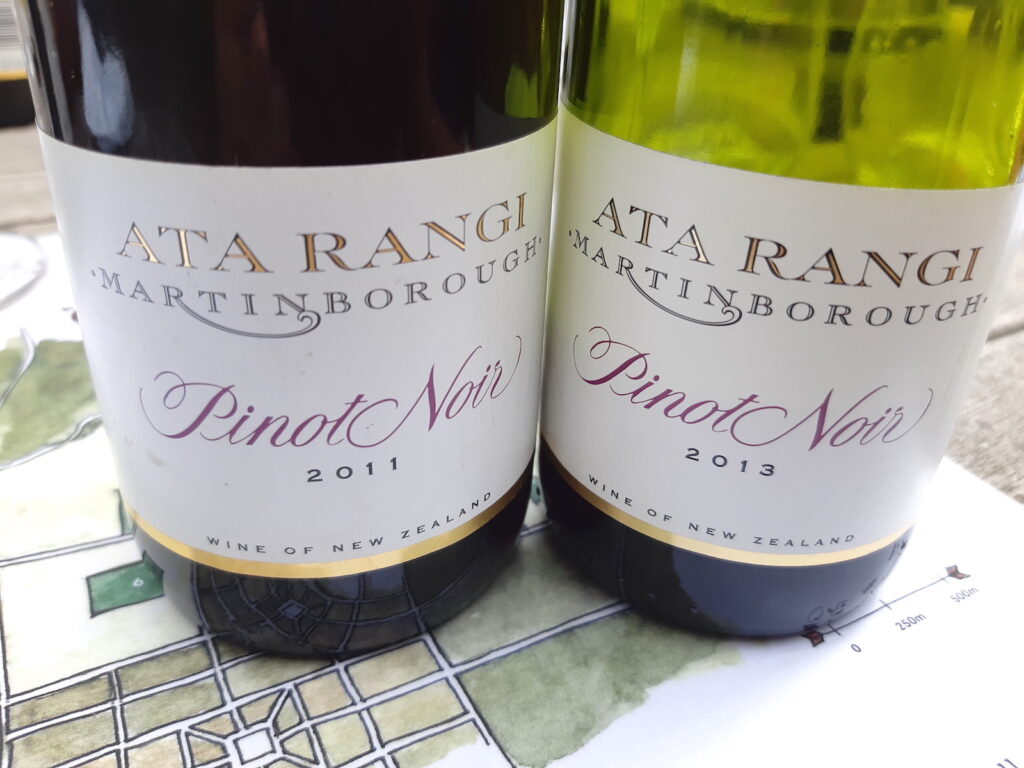
HM: I’m so proud of the 2011 – that was a really tough vintage. We were frosted – flowering was really not great at all. Very small bunches and it was really hard to get a good natural balance because there was so much skin and seed pulp. It has always been quite angular and harder to make your way through and see that line of freshness. But this is one that has really pulled itself together with age. ’13 was a much easier vintage. Much more natural brightness… in ’18 we had a really nice set. A good start, but the thing about ’18 was that it was very humid in January and February, so the skins were a little bit thinner. The wine is quite perfumed and delicate. It’s not all about concentration, but about finesse. But it was a hard vintage because we had a massive cyclone come through. Luckily all the Ata Rangi fruit was picked before that came through. You’ve got to know your producers a bit and be a bit picky about ’18.
CP: Certainly in the last twenty years, the best one we had was 2013. The diurnal shift – where we had a warm summer but the nights were really cold – was fantastic. That really helps with flavour development and acidity retention. That’s why the best winemaking places around the world have that cold air at night.

